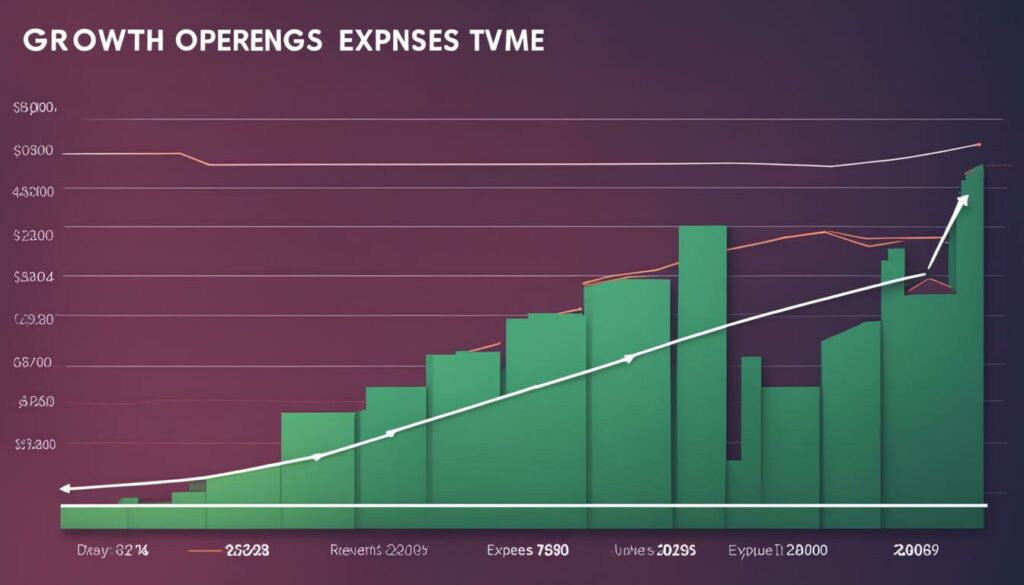Operating expenses are a crucial aspect of running an ecommerce business. As an ecommerce business owner, understanding and managing your operating expenses effectively is essential for financial stability and profitability. In this article, I will provide an overview of operating expenses in ecommerce, their definition, calculation, and importance. I will also share strategies to reduce operating expenses and discuss the relationship between operating expenses and other financial metrics.
Key Takeaways:
- Operating expenses are the day-to-day expenses incurred by an ecommerce business to keep their operations running smoothly.
- These expenses include rent, payroll, inventory, essential equipment, advertising and marketing expenses, and more.
- Operating expenses are different from capital expenses and non-operating expenses.
- Effectively managing operating expenses can improve profitability and maintain financial stability.
- Strategies to reduce operating expenses include inventory management, negotiating pricing with suppliers, and leveraging technology.
Definition of Operating Expenses
Operating expenses, also known as OpEx, are the essential expenses incurred by a business in its day-to-day operations. These expenses encompass various costs that are necessary for the regular functioning of the business.
- Rent
- Payroll
- Inventory
- Essential equipment
- Business insurance
- Advertising and marketing expenses
Operating expenses are crucial for the smooth running of an ecommerce business. They play a fundamental role in supporting the core operations and maintaining business sustainability. Effective management of operating expenses is vital to ensure financial stability as well as to enhance profitability.
Operational efficiency and cost optimization are essential to maximize profitability in ecommerce. By carefully managing operating expenses, businesses can allocate resources effectively and improve their bottom line.
Understanding and closely monitoring operating expenses is key for ecommerce business owners. By analyzing and controlling these expenses, business owners can make informed decisions and implement strategies to optimize costs and improve overall financial health. By doing so, they can maintain a competitive edge and achieve long-term success in the ecommerce industry.

Calculating Operating Expenses
Calculating operating expenses is essential for ecommerce business owners to effectively manage their finances. By accurately tracking and analyzing these expenses, businesses can make informed decisions and optimize their operations. Let’s explore the factors involved in calculating operating expenses and the formula to determine them.
Factors Affecting Operating Expenses
Several factors can influence the calculation of operating expenses for an ecommerce business. These factors include:
- Salaries and Wages: The costs associated with employee compensation, including salaries, benefits, and payroll taxes.
- Utilities: Expenses for electricity, water, internet, and other utility services necessary for business operations.
- Shipping: Costs related to shipping and delivery services, packaging materials, and order fulfillment.
- Marketing and Advertising: Expenditures for advertising campaigns, social media promotions, influencer collaborations, and other marketing efforts.
- Equipment and Asset Maintenance: Costs associated with the maintenance, repair, and replacement of essential equipment and assets.
- Legal Fees: Expenses incurred for legal services, such as trademark registration, contract drafting, and compliance consultations.
- Platform Charges: Fees charged by ecommerce platforms or marketplaces for using their services and features.
- Insurance: Premiums paid for business insurance coverage, including general liability, product liability, and property insurance.
Operating Expenses Formula
The formula for calculating operating expenses is straightforward:
Operating Expenses = Salaries and Wages + Utilities + Shipping + Marketing and Advertising + Equipment and Asset Maintenance + Legal Fees + Platform Charges + Insurance
However, it is important to adapt the formula to the specific costs incurred by each ecommerce business. This allows for a more accurate calculation and a better understanding of the business’s financial position.
For example, an ecommerce company that heavily relies on digital marketing might allocate a larger portion of its operating expenses to marketing and advertising compared to a business that focuses on organic growth and word-of-mouth marketing.
By utilizing this formula and customizing it to their business needs, ecommerce entrepreneurs can gain valuable insights into their operating expenses and identify areas for cost optimization.
Next, we will explore the importance of operating expenses in ecommerce and how effectively managing them can improve profitability and long-term sustainability.
Importance of Operating Expenses in Ecommerce
Operating expenses are a critical aspect of running a successful ecommerce business. Effective management and reduction of operating expenses can have a significant impact on improving profit margins and overall profitability. Operating expenses directly influence the financial health of the business and should be carefully monitored and controlled to ensure long-term sustainability. By minimizing unnecessary expenses, optimizing processes, and implementing cost-effective solutions, ecommerce businesses can enhance their bottom line and thrive in a competitive market.
Managing operating expenses is essential for maintaining a healthy profit margin. By reducing unnecessary costs, ecommerce businesses can allocate more resources towards revenue-generating activities. This helps increase profitability and ensures a higher return on investment. Additionally, efficient management of operating expenses leads to better cash flow management, providing the necessary liquidity to support business operations and growth.
The Impact of Operating Expenses on Profitability
Operating expenses directly impact the profitability of an ecommerce business. High and uncontrolled operating expenses can eat into the revenue generated by sales, resulting in lower profit margins. By accurately tracking and managing operating expenses, businesses can identify areas where costs can be reduced or eliminated, leading to increased profitability.
Reducing operating expenses can be achieved through various strategies, such as renegotiating contracts with suppliers to secure better pricing, implementing energy-saving measures to reduce utility costs, and optimizing inventory management to minimize storage and handling expenses. By implementing these cost-saving initiatives, ecommerce businesses can enhance their profit margins and reinvest the savings into strategic areas to drive growth.
“Effective management of operating expenses is key to improving profit margins and ensuring the long-term success of an ecommerce business.”
Managing Operating Expenses in Ecommerce
Effectively managing operating expenses requires a comprehensive approach that involves analyzing and optimizing various cost areas. Ecommerce businesses should regularly review their expenses and identify opportunities for cost reduction and efficiency improvement. Some strategies to manage operating expenses include:
- Implementing cost control measures to reduce unnecessary expenses
- Optimizing pricing and procurement strategies to secure better deals
- Streamlining operational processes to improve efficiency
- Investing in technology to automate tasks and reduce labor costs
- Monitoring and analyzing expenses to identify trends and areas for improvement
By actively managing operating expenses, ecommerce businesses can achieve better financial stability, increase profitability, and position themselves for sustained growth and success in the competitive online marketplace.
| Benefits of Managing Operating Expenses | Actions to Reduce Operating Expenses |
|---|---|
| Improved profit margins | Negotiating better deals with suppliers |
| Better cash flow management | Optimizing energy consumption |
| Enhanced financial stability | Implementing inventory management best practices |
| Increased reinvestment opportunities | Automating repetitive tasks |

Strategies to Improve Operating Expenses in Ecommerce
Ecommerce business owners can employ various effective strategies to reduce operating expenses, optimize costs, and ensure financial stability. By implementing these strategies, they can improve the overall profitability of their ecommerce businesses.
1. Conduct routine inventory checks
Regularly monitoring and managing inventory can help identify and eliminate excess stocks. By avoiding overstocking, ecommerce businesses can minimize carrying costs and reduce the risk of inventory obsolescence.
2. Negotiate pricing with manufacturers and suppliers
Establishing strong relationships with manufacturers and suppliers can enable ecommerce businesses to negotiate favorable pricing terms. This can lead to cost savings, especially when purchasing raw materials, products, or services in bulk.
3. Create and adhere to a budget
Developing a comprehensive budget that outlines projected expenses and revenue targets is vital. By closely tracking expenses and adhering to the budget, ecommerce businesses can effectively control costs and identify areas for potential cost-cutting.
4. Outsource certain services
Consider outsourcing non-core functions such as customer support, IT maintenance, or product fulfillment. Outsourcing these tasks to specialized service providers can yield cost savings while maintaining quality and efficiency.
5. Focus on customer retention
Investing in customer retention strategies is an effective way to reduce marketing costs. By providing exceptional customer service, offering loyalty programs, and creating a personalized shopping experience, ecommerce businesses can encourage repeat purchases and minimize customer acquisition expenses.
6. Leverage technology to streamline processes
Implementing technology solutions such as automated inventory management systems, analytics tools, and cloud-based platforms can streamline operations and reduce human error. This optimization helps in managing expenses effectively.
“Implementing cost-cutting strategies and optimizing operating expenses is crucial for the long-term sustainability and growth of ecommerce businesses.”
Customer Behavior and Operating Expenses
Customer behavior plays a significant role in the operating expenses of ecommerce businesses. The impact of customer behavior on expenses can be seen in the form of returns and refunds, which can increase operational costs.
High return rates can lead to additional expenses such as restocking and disposal costs, negatively affecting profit margins. In order to reduce returns and refunds, ecommerce businesses need to implement effective customer retention strategies.
One strategy is to offer excellent customer service. By providing prompt and personalized assistance, businesses can address customer concerns and minimize the likelihood of returns.
Another strategy is to provide detailed product information to set accurate customer expectations. By providing comprehensive product descriptions, specifications, and images, businesses can help customers make informed purchasing decisions, reducing the chances of dissatisfaction and subsequent returns.
“Offering a generous return policy can also help reduce returns and refunds. By giving customers the reassurance that they can easily return or exchange items, businesses can instill confidence and encourage them to complete their purchase.”
By understanding and addressing customer behavior, ecommerce businesses can effectively manage their operating expenses and improve profitability.

| Customer Retention Strategies | Benefits | |
|---|---|---|
| Offer excellent customer service | – Reduces returns and refunds | – Builds customer loyalty and satisfaction |
| Provide detailed product information | – Minimizes the chances of incorrect expectations | – Reduces returns due to mismatched customer needs |
| Implement a generous return policy | – Instills confidence and encourages purchase | – Reduces customer hesitation and abandonment |
Relation of Operating Expenses to Other Metrics
Operating expenses in ecommerce have a direct impact on various financial metrics that are crucial for business success. Effective management and analysis of operating expenses are key to achieving profitability, maintaining cash flow, ensuring financial stability, and driving business growth.
Operating Expenses and Profitability
Understanding the relationship between operating expenses and profitability is essential for ecommerce business owners. By carefully monitoring and controlling operating expenses, businesses can increase their profit margins. Lowering unnecessary expenses, optimizing processes, and finding cost-effective solutions can significantly impact profitability.
Operating Expenses and Cash Flow
Cash flow is the lifeblood of any business, and operating expenses play a vital role in managing cash flow effectively. By accurately tracking and managing operating expenses, ecommerce businesses can ensure a steady inflow and outflow of cash, preventing any disruptions in their operations.
Operating Expenses and Financial Stability
Operating expenses directly influence the overall financial stability of an ecommerce business. By keeping operating expenses in check and maintaining a healthy financial position, businesses can withstand any unforeseen challenges or economic downturns and continue to operate smoothly.
Operating Expenses and Business Growth
Operating expenses are integral to business growth in ecommerce. By analyzing operating expenses in relation to revenue, businesses can identify areas where costs can be optimized and investments can be made. This ensures that resources are allocated effectively, supporting sustainable business growth over time.
Analyzing Operating Expenses
Regular analysis of operating expenses allows ecommerce businesses to gain valuable insights into their financial performance. By scrutinizing expense trends and patterns, businesses can make informed decisions to optimize their operations and improve their overall financial health.
“Accurately tracking and managing operating expenses is crucial for ecommerce businesses to achieve profitability, maintain cash flow, ensure financial stability, and drive sustainable growth.”

Next, we’ll explore strategies to improve operating expenses in ecommerce, including cost-cutting measures and optimizing the cost structure.
Challenges and Considerations of Operating Expenses in Ecommerce
Managing operating expenses in ecommerce poses unique challenges and requires careful consideration. As an ecommerce business owner, I understand the importance of striking a balance between cost control and providing high-quality products and services. It’s crucial to optimize our cost structure while maintaining customer satisfaction.
One of the primary challenges is the ever-changing market trends. Staying ahead of the curve and adapting to consumer demands can directly impact operating expenses. We must continuously assess the market dynamics and make proactive adjustments to our strategies to ensure efficient cost management.
Competition is another factor to consider. As more businesses enter the ecommerce space, it becomes essential to find innovative ways to differentiate ourselves while keeping operating expenses in check. This could involve investing in technologies that streamline operations, automate processes, and reduce manual labor, ultimately optimizing our cost structure.
Moreover, technological advancements can both present opportunities and challenges. While technology can increase efficiency and reduce costs in some areas, it may also require investments and ongoing maintenance expenses. As an ecommerce business owner, I need to carefully evaluate the potential return on investment and weigh the benefits against the operating expenses incurred.
In conclusion, managing operating expenses in ecommerce requires addressing various challenges and considerations. By carefully balancing cost control, monitoring market trends, navigating competition, and leveraging technology, I can optimize my cost structure and ensure the financial stability of my ecommerce business.
FAQ
What are operating expenses in ecommerce?
Operating expenses are the expenses incurred by an ecommerce business in the day-to-day running of its activities. These expenses include costs such as rent, payroll, inventory, essential equipment, advertising and marketing expenses, and more.
How can operating expenses be reduced in ecommerce?
Operating expenses in ecommerce can be reduced by implementing strategies such as conducting routine checks on inventory, negotiating pricing with manufacturers and suppliers, creating and sticking to a budget, outsourcing certain services, focusing on customer retention to reduce marketing costs, and leveraging technology to streamline processes.
What is the definition of operating expenses?
Operating expenses, also known as OpEx, are the expenses incurred by a business in its day-to-day operations. These expenses are necessary for the regular functioning of the business and include costs like rent, payroll, inventory, essential equipment, business insurance, advertising and marketing expenses, and more.
How do you calculate operating expenses?
Operating expenses can be calculated by adding up all the expenses incurred by a business in its day-to-day operations. The formula for calculating operating expenses includes costs like salaries and wages, utilities, shipping, marketing and advertising, equipment and asset maintenance, legal fees, platform charges, and insurance.
What is the importance of operating expenses in ecommerce?
Operating expenses play a significant role in the profitability of an ecommerce business. By effectively managing and reducing operating expenses, ecommerce business owners can improve their profit margins. Operating expenses directly impact the financial health of a business and need to be carefully monitored and controlled.
What are some strategies to improve operating expenses in ecommerce?
Ecommerce business owners can implement various strategies to improve their operating expenses. Some strategies include conducting routine checks on inventory to eliminate excess stocks, negotiating pricing with manufacturers and suppliers, creating and sticking to a budget, outsourcing certain services, focusing on customer retention to reduce marketing costs, and leveraging technology to streamline processes and reduce expenses.
How does customer behavior impact operating expenses in ecommerce?
Customer behavior can have a direct impact on operating expenses in ecommerce. High return rates can increase expenses related to returns and refunds, including restocking and disposal costs. Ecommerce businesses can implement customer retention strategies to reduce returns and refunds, such as offering excellent customer service, providing detailed product information, and implementing a generous return policy.
What is the relation of operating expenses to other metrics in ecommerce?
Operating expenses are closely related to other financial metrics in ecommerce. They directly impact profitability, cash flow, and overall financial stability. By analyzing operating expenses in relation to revenue, ecommerce businesses can assess their financial performance and identify areas for improvement.
What are the challenges and considerations of managing operating expenses in ecommerce?
Managing operating expenses in ecommerce comes with various challenges and considerations. Ecommerce business owners need to carefully balance cost control while maintaining the quality of products and services. They should also consider factors like changing market trends, competition, and technological advancements that can impact operating expenses. It is important to regularly review and adjust strategies for managing operating expenses to adapt to the evolving ecommerce landscape and ensure financial stability.
